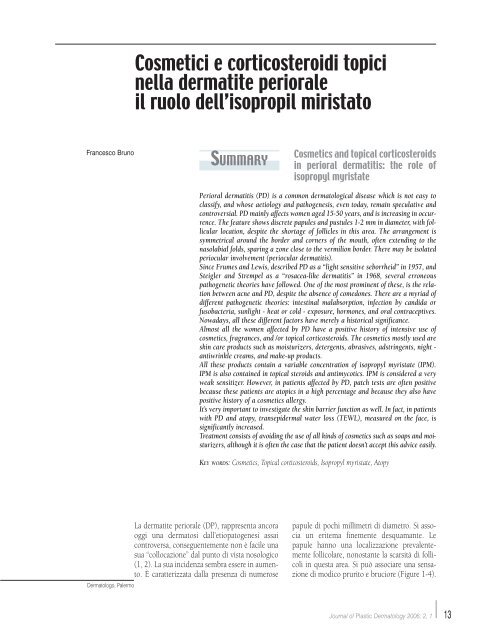Aprile Vol.2 N° 1 - 2006 - Salute per tutti
Aprile Vol.2 N° 1 - 2006 - Salute per tutti
Aprile Vol.2 N° 1 - 2006 - Salute per tutti
Create successful ePaper yourself
Turn your PDF publications into a flip-book with our unique Google optimized e-Paper software.
Cosmetici e corticosteroidi topici<br />
nella dermatite <strong>per</strong>iorale<br />
il ruolo dell’isopropil miristato<br />
Francesco Bruno<br />
SUMMARY<br />
Cosmetics and topical corticosteroids<br />
in <strong>per</strong>ioral dermatitis: the role of<br />
isopropyl myristate<br />
Dermatologo, Palermo<br />
Perioral dermatitis (PD) is a common dermatological disease which is not easy to<br />
classify, and whose aetiology and pathogenesis, even today, remain speculative and<br />
controversial. PD mainly affects women aged 15-50 years, and is increasing in occurrence.<br />
The feature shows discrete papules and pustules 1-2 mm in diameter, with follicular<br />
location, despite the shortage of follicles in this area. The arrangement is<br />
symmetrical around the border and corners of the mouth, often extending to the<br />
nasolabial folds, sparing a zone close to the vermilion border. There may be isolated<br />
<strong>per</strong>iocular involvement (<strong>per</strong>iocular dermatitis).<br />
Since Frumes and Lewis, described PD as a “light sensitive seborrheid” in 1957, and<br />
Steigler and Strempel as a “rosacea-like dermatitis” in 1968, several erroneous<br />
pathogenetic theories have followed. One of the most prominent of these, is the relation<br />
between acne and PD, despite the absence of comedones. There are a myriad of<br />
different pathogenetic theories: intestinal malabsorption, infection by candida or<br />
fusobacteria, sunlight - heat or cold - exposure, hormones, and oral contraceptives.<br />
Nowadays, all these different factors have merely a historical significance.<br />
Almost all the women affected by PD have a positive history of intensive use of<br />
cosmetics, fragrances, and /or topical corticosteroids. The cosmetics mostly used are<br />
skin care products such as moisturizers, detergents, abrasives, adstringents, night -<br />
antiwrinkle creams, and make-up products.<br />
All these products contain a variable concentration of isopropyl myristate (IPM).<br />
IPM is also contained in topical steroids and antimycotics. IPM is considered a very<br />
weak sensitizer. However, in patients affected by PD, patch tests are often positive<br />
because these patients are atopics in a high <strong>per</strong>centage and because they also have<br />
positive history of a cosmetics allergy.<br />
It’s very important to investigate the skin barrier function as well. In fact, in patients<br />
with PD and atopy, transepidermal water loss (TEWL), measured on the face, is<br />
significantly increased.<br />
Treatment consists of avoiding the use of all kinds of cosmetics such as soaps and moisturizers,<br />
although it is often the case that the patient doesn’t accept this advice easily.<br />
KEY WORDS: Cosmetics, Topical corticosteroids, Isopropyl myristate, Atopy<br />
La dermatite <strong>per</strong>iorale (DP), rappresenta ancora<br />
oggi una dermatosi dall’etiopatogenesi assai<br />
controversa, conseguentemente non è facile una<br />
sua “collocazione” dal punto di vista nosologico<br />
(1, 2). La sua incidenza sembra essere in aumento.<br />
È caratterizzata dalla presenza di numerose<br />
papule di pochi millimetri di diametro. Si associa<br />
un eritema finemente desquamante. Le<br />
papule hanno una localizzazione prevalentemente<br />
follicolare, nonostante la scarsità di follicoli<br />
in questa area. Si può associare una sensazione<br />
di modico prurito e bruciore (Figure 1-4).<br />
Journal of Plastic Dermatology <strong>2006</strong>; 2, 1<br />
13

















